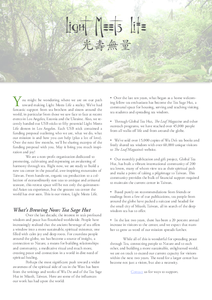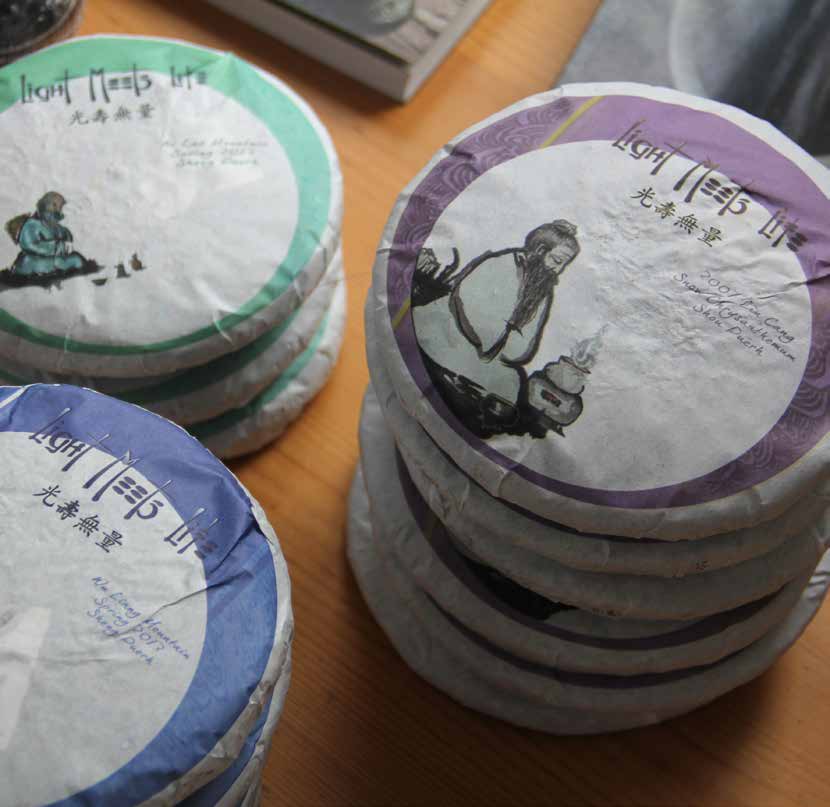
 |
|
You might be wondering where we are on our path toward making Light Meets Life a reality. We've had fantastic support from tea brothers and sisters around the world, in particular from those we saw face to face at recent events in Los Angeles, Estonia and the Ukraine. Also, we recently handed out USB sticks to fifty potential Light Meets Life donors in Los Angeles. Each USB stick contained a funding proposal outlining who we are, what we do, what our mission is and how you can help (plus a lot of love). Over the next few months, we'll be sharing excerpts of the funding proposal with you. May it bring you much inspiration and joy!

We are a non-profit organization dedicated to promoting, cultivating and expressing an awakening of harmony through tea. Right now, we are ready to build a new tea center in the peaceful, awe-inspiring mountains of Taiwan. From hands-on, organic tea production to a collection of extraordinarily rare teas to antique and artisanal teaware, this retreat space will be not only the quintessential Asian tea experience, but the greatest tea center the world has ever seen. This is our vision, Light Meets Life.
Over the last decade, the interest in tea's profound wisdom and peace has flourished worldwide. People have increasingly realized that the ancient beverage of tea offers a window into a more sustainable, spiritual existence, one filled with calm joy and deep roots. For countless people around the globe, tea has become a source of insight, a connection to Nature, a means for building relationships and community, a meditative ritual and much more, creating peace and connection in a world in dire need of spiritual healing.
Perhaps the most significant push toward a wider awareness of the spiritual side of tea in the West has been from the writings and works of Wu De and of the Tea Sage Hut in Miaoli, Taiwan. Here are some of the influences our work has had upon the world:
While all of this is wonderful for spreading peace through Tea, connecting people to Nature and to each other, and building a more sustainable, enlightened world, we are on track to exceed our current capacity for visitors within the next two years. The need for a larger center has become not just a vision, but also a necessity.
Contact us for ways to support.

Shen Nong means "Divine Farmer" in Chinese. He is the legendary emperor who ruled China for a thousand years, teaching the people to farm, boil water and the use of medicinal herbs - bringing them civilization. He most likely represents the collective wisdom of all the tribal chiefs and shamans of pre-civilized China. They say he discovered tea while meditating in the forest. A single leaf fell into his boiling pot of water, and he exclaimed: "This is the ruler of all medicinal herbs!"
The first cake is a 2007 organic Lin Cang Shou Puerh blended with Kun Lun snow chrysanthemums. It is very rare to find a shou Puerh that is organic and has some old-growth raw material, especially since the price of such old tree tea has gone up recently. In 2007, however, it was still possible. The five years have also helped to mellow out the tea, adding depth. Snow Chrysanthemum tea is a rare and highly sought-after high altitude flower tea from Kunlun Mountain, Gansu Province, China. The flowers are picked and sun-dried once a year (late summer), then hand-sorted into various grades. This is the highest grade available, and it brews a lovely liquor with a strong sweet and spicy flavor. It is thought that properties within the chrysanthemum flower have a calming effect that aids sleep. In the Traditional Chinese Materia Medica, Snow Chrysanthemum is said to restore respiratory fitness, regulate blood pressure and prevent cancer.
Lu Yu wrote the oldest known book on tea, called simply "The Classics of Tea". In it he extolled the virtues of tea, discussed water and fire, processing and preparation methods and a deep and spiritual love of tea. One of the most poignant aspects of the book was when he declared that tea was the only time of day that he could rest assured that at that very moment he was sharing the same activity with the august emperor himself - ultimately, expressing the equality inherent in a life of tea. The tea space is one where we leave behind the dust of the ego: our names, our jobs, our social or economic status, our gender - none of it matters in a space of one heart!
This cake is a 2013 Wu Liang. The Wu Liang Mountains peak out at about 3300 meters, making them the tallest mountains in Simao prefecture. The Wu Liang mountain range is in the county of Jing Dong, which borders both Lin Cang and Da Li prefectures. This tea is grown in the area of Wu Liang known as Zhong Cang village at an altitude of 2300 meters. The trees are around 200 years old. These tea gardens are remote and pristine, untouched by any of the environmental problems that other parts of Yunnan face.
Even when young this tea is full in the mouth giving the drinker a persistent warmth and lubricated mouth feel. It's never harsh and never drops off suddenly, thus revealing the healthy characteristics of the trees and environment from which it came. This tea will develop gracefully through years building its character and providing the drinker with ever more complex textures as it ages.
This tea was compressed with traditional stone presses in a small tea factory near Kunming. The tea was also sun-dried according to ancient ways.
Baisao was an eighteenth century tea sage whose bright spirit illuminates our tradition in more than name alone. A Zen monk for most of his life, at the age of forty-nine he traded in his robes for what was paradoxically the more Zen-infused life of a roadside peddler of tea. His bowls were steeped in the ancient and priceless Spirit of Tea, unclouded by money, theory, ritual or even mind itself - a spirit from before the first fingers plucked the first leaves. And those who came by his wayside hut just might have passed by the old man so strangely donning the crane robes of an ancient Taoist hermit, but for the way the spirit twinkled invitingly in his eyes or the softness of his hands as he poured his tea into worn and cracked bowls... And after such a bowl, the passerby left changed somehow, though perhaps not able to grasp the importance of what exactly had shifted their perspective. Commenting on the famous poem by the tea saint Lu Tong called "Seven Bowls" in which Lu Tong describes the higher and higher reaches of each successive bowl of fine tea, Baisao cheekily declared that "Old Lu Tong needed seven bowls to get there, but you'll only need the one of mine..."
The last cake is an Ai Lao. These mountains rise to about 3200 meters, making them second only to Wu Liang Shan as the highest mountains in Simao prefecture. The Ai Lao mountain range is in the county of Jing Dong, which borders Chu Xiong prefecture. This tea is grown in the area of Ai Lao known as Wang Jia village at an altitude of 2200 meters, making this some of the highest altitude Puerh in existence. The trees are healthy 200-year-old trees growing naturally on steep hillsides and ridges. These tea gardens are arguably some of the remotest tea gardens in all of Yunnan. Lack of roads and access has kept the environment of this area in good condition.
The tea itself is filled with hints of an orchid aroma, and a strong mouth-feel. Honey and grass essences are also present in this thick, soupy tea. This tea (in its young age) is subtler than the Wu Liang Lan Xiang cake, with less bitterness and a stronger aroma. The leaves are fatter and burlier than our Wu Liang tea. It features lots of hairy buds that make it somewhat resemble its close neighbors, Jing Gu Mountain teas.
Like the Wu Liang, this tea was also compressed with traditional stone presses in a small tea factory near Kunming. The tea was also sun-dried according to ancient ways.
If you want to purchase any of the cakes, contact us at: globalteahut@gmail.com